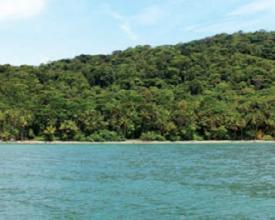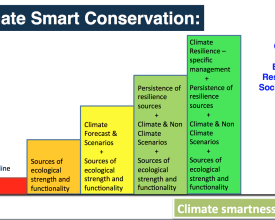
Conservación climáticamente inteligente de las zonas marinas protegidas

El Marco de Adaptación al Cambio Climático para Áreas Marinas Protegidas aborda la necesidad de desarrollar una metodología marco que integre acciones técnicas para evaluar los riesgos climáticos y la resiliencia de los objetivos de conservación del área protegida, la priorización de acciones de adaptación al clima, la implementación de acciones prioritarias para aumentar la resiliencia y la capacidad de adaptación; y la integración de medidas de adaptación con las herramientas de planificación existentes en el Parque Nacional Gorgona, Colombia, para las partes interesadas locales.
Contexto
Défis à relever
La vulnerabilidad del ecosistema al cambio climático, la falta de actividades de conservación Proporciona un marco que permite a los administradores de áreas protegidas en Colombia integrar las acciones necesarias para aumentar la resiliencia de los ecosistemas costeros y marinos dentro del marco de planificación existente, fortaleciendo la capacidad de las áreas protegidas para proporcionar bienes y servicios ambientales, y para beneficiar a los objetivos de conservación y a las comunidades frente a las condiciones climáticas existentes y futuras.
Ubicación
Procesar
Resumen del proceso
Los bloques de construcción interactúan en el desarrollo de un marco conceptual que permite la conservación climáticamente inteligente en áreas protegidas: 1. 1. Proporciona orientación práctica y científicamente sólida para facilitar la planificación de la adaptación al clima; 2. Basándose en la comprensión de los riesgos climáticos y la resiliencia climática que determinan la vulnerabilidad, facilita la toma de decisiones sobre las medidas de adaptación más adecuadas.
Bloques de construcción
Objetivos de conservación
Factores facilitadores
Lección aprendida
Evaluación de la vulnerabilidad
Factores facilitadores
Lección aprendida
Formulación de medidas de adaptación
Factores facilitadores
Lección aprendida
Aplicación de medidas prioritarias de adaptación al clima
Factores facilitadores
Lección aprendida
Impactos
- Ecológico: El PN de Gorgona pretende mantener la integridad ecológica de sus objetos de conservación, en particular los arrecifes de coral y el ecosistema pelágico. Para ello, el AP evalúa periódicamente (cada 4-5 años) la integridad ecológica de sus objetivos de conservación y supervisa los beneficios de la adaptación al clima. - Social: Permite a las pesquerías locales coordinar sus actividades para proteger un recurso común. También aumenta la información y el conocimiento sobre los beneficios del AP. - Económicos: Se espera un aumento de las poblaciones de peces. El seguimiento se lleva a cabo en este momento para informar de resultados precisos.
Beneficiarios
autoridades de zonas protegidas, comunidades pesqueras costeras, comunidades pesqueras locales, autoridades locales y regionales de medio ambiente y planificación, gestores de zonas protegidas, comités regionales de medio ambiente, ONG locales, universidades e investigadores
Historia
El Parque Nacional de Gorgona es una de las áreas protegidas más representativas de Colombia. Debido a su rica biodiversidad y a la gran cantidad de investigaciones realizadas sobre sus ecosistemas terrestres, costeros y marinos, se le conoce como la "Isla de la Ciencia". Aunque en la isla no viven comunidades locales, éstas dependen en gran medida de los recursos que proporciona la llamada "región Gorgona-Sanquianga" (Sanquianga es otro Parque Nacional, y protege el ecosistema de manglares más importante de la costa suroccidental de Colombia).
Consciente de su responsabilidad y de la importancia del parque, la administración del Parque Nacional Gorgona ha actualizado su Plan de Gestión para el periodo 2015-2019, teniendo en cuenta un contexto regional más allá de sus propios límites geográficos, e incluyendo por primera vez un enfoque de servicios ecosistémicos y consideraciones sobre el cambio climático. Estas consideraciones sobre el cambio climático no solo forman parte de un análisis para establecer mejores medidas de conservación sobre objetos de conservación, ecosistemas y especies, sino para mantener recursos clave para las comunidades que basan su sustento en las actividades legales fuera del Parque, como la pesca.
El proceso de fortalecimiento de capacidades ha incluido al personal del Parque, a los actores locales, el apoyo del equipo técnico de WWF y los aportes y recomendaciones de otros actores. Los Parques y WWF Colombia adquirieron nuevas habilidades y capacidad técnica a través de esta primera experiencia. Para mantener el ritmo de otras organizaciones de conservación y asesorar a otras áreas protegidas, sigue siendo necesario desarrollar mejores habilidades y fortalecer y ampliar los equipos de conservación de Climate Smart. A corto plazo, esto puede hacerse mediante la formación del personal en materia de adaptación al clima, biodiversidad y ciencia del clima, y herramientas y técnicas de modelización SIG.
Al final, las medidas de adaptación al cambio climático y las evaluaciones de vulnerabilidad en Gorgona han sido un esfuerzo de equipo que incluye diferentes niveles de conocimiento, capacidades e interés, pero sobre todo, muestra la responsabilidad y la voluntad de Gorgona y WWF para preservar los recursos más valiosos del Pacífico en Colombia.






